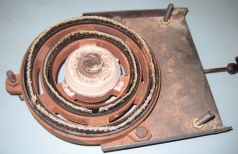

New Aga

We moved into our present home over ten years ago and the only means of cooking was a two-oven oil-fired Aga. We soon got used to this and although cooking on kerosene sounded pretty uncivilised, we soon realised that the Aga did more than just cook: it heated the domestic hot water, ironed clothes and kept the house warm so that it was always welcoming. When we decided to refurbish the kitchen we decided to have a new four-oven Aga with an integrated electric cooker. The whole arrangement is shown here - this isn't actually ours but it is identical.
Naively we thought that replacing one Aga with another would be straight forward: old one out, new one in and connnect up. No: Building Regulations and Aga designs had progressed in the meantime and we found we had to:
- replace the hot water cylinder with an indirect one (the old Aga has a glass-lined boiler so uses a direct feed)
- line the brick chimney with a stainless steel liner
- sweep the chimney before the liner was installed
- provide a 100mm diameter ventilation hole in the kitchen wall so that we do not die of asphyxiation when the Aga is lit
- install a second fire valve outside
The ovens going clockwise from top left:
- normal electric oven/grill
- simmering oven
- roasting oven
- baking oven
- centre door is the oil burner
- warming oven
- electric fan oven
The two hot plates have circular lids, the left one is shown open above. This is the boiling ring, the other to the right is the simmering ring. The area to the left of the hot plates is a flat area that can be used for keeping food warm, ironing clothes, etc. To the left again are four electric rings in a ceramic hob.
The Aga comes complete with oven rails, enamelled trays, a bread toaster, a cold shelf (for splitting the oven into two temperature zones), etc.

Unlike central heating boilers, which can usually run on all sorts of fuel if coaxed, oil Agas can only use kerosene (paraffin). This is currently taxed at 5% VAT for domestic use in line with electricity and gas. The burner is a flate plate with two concentric circular grooves about 2cm deep connected by six radial tubes to each other and to a central pot with a lid. The two grooves contain wicks that are used to light the burner. Fuel flows into the pot where it travels outwards to the wicks. Once the burner is hot, the incoming fuel vapourises in the pot and travels as vapour through the tubes to the burner where it burns. Over time the wicks gradually become choked with carbon and need replacing every year, though those with a vested interest recommend six-monthly decoking. The oil feed pipe near to the burner and the pot also become carbonised and are cleaned at the same time. A typical service is about £100 but a set of wicks cost less than £10 so you can make a tidy saving if you're prepared to do it yourself.